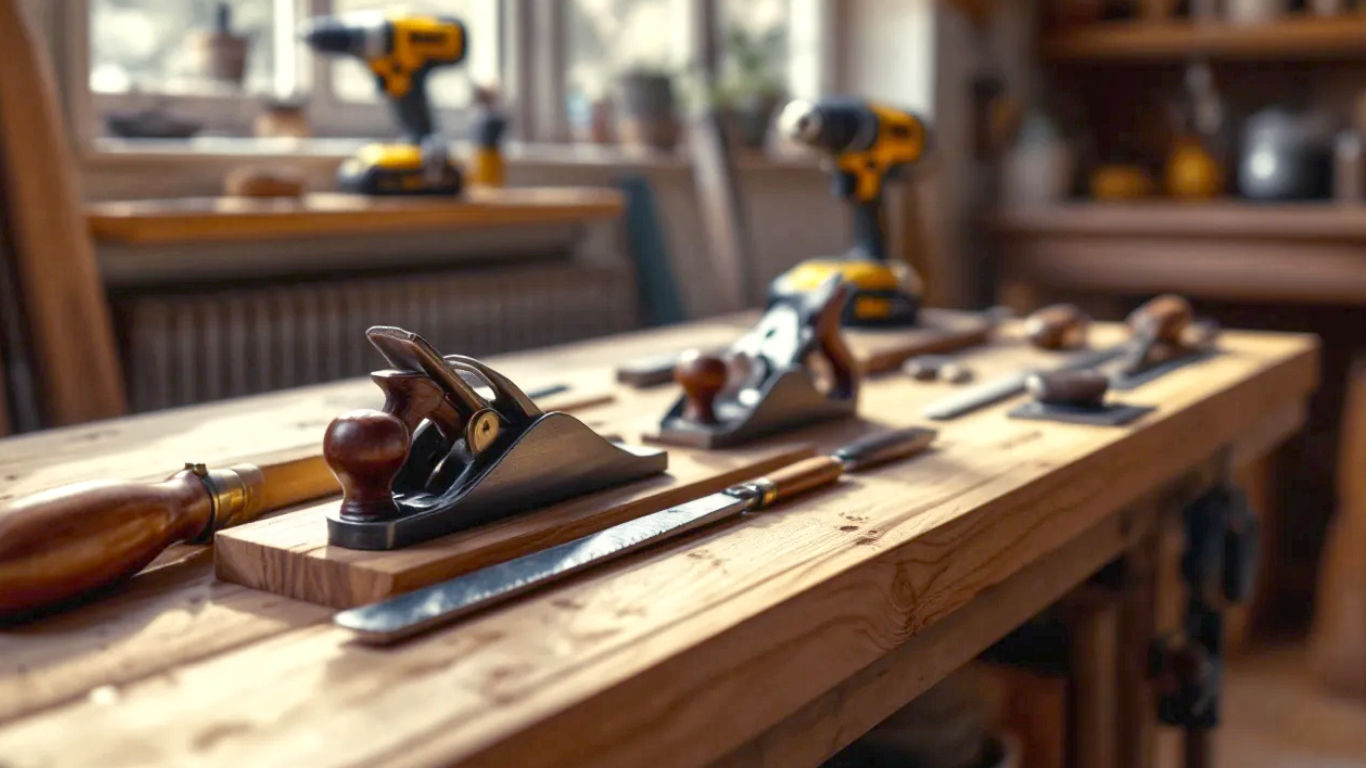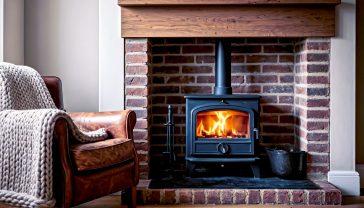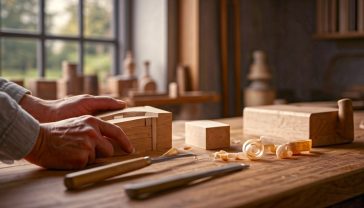From Whittling to Cabinetry: The Ultimate Guide to Choosing Woodcraft Tools
A complete guide for British beginners on choosing woodcraft tools. Learn about essential hand tools, must-have power tools, and how to build your workshop.

This post may contain affiliate links. If you make a purchase through these links, we may earn a commission at no additional cost to you.
Woodcraft is one of Britain’s oldest and most satisfying crafts. From the mighty ships that once ruled the waves to the humble garden shed, our history is carved in wood. There’s something deeply rewarding about taking a rough piece of timber and shaping it into something beautiful and useful with your own hands. But if you’re just starting, the world of woodworking tools can feel a bit daunting. What’s the difference between a tenon saw and a dovetail saw? Do you really need a mortise gauge? And what on earth is a router for?
Don’t worry. Choosing the right tools isn’t as complicated as it seems. Think of it like learning to cook. You don’t need a Michelin-star kitchen to make a decent bacon butty; you just need a few good basics. This guide will walk you through everything you need to know, whether you’re planning to whittle a simple spoon or build a masterpiece of a bookshelf. We’ll cover the essential hand tools that have served carpenters for centuries, the power tools that make life easier, and how to choose the right ones for your budget and your ambitions.
We’ll break it all down, explain what each tool does, and give you practical tips to help you build a collection you can rely on. So, grab a cuppa, and let’s get started on your journey into the wonderful world of woodcraft.
The Heart of the Workshop: Essential Hand Tools
Before power tools buzzed and whirred, everything was made by hand. And honestly, for many jobs, hand tools are still the best. They’re quieter, they give you more control, and the only power they need is a bit of elbow grease. For anyone serious about woodcraft, mastering the basics of hand tools is non-negotiable. They teach you to understand the wood—how it feels, how it cuts, and how it behaves.
Think of your hand tool collection as your core team. You don’t need dozens of them to start, just a few reliable players who can handle most tasks. Here’s a look at the absolute must-haves for any British workshop.
Measuring and Marking: The Foundation of Accuracy
There’s an old saying in woodworking: “Measure twice, cut once.” It’s a cliché for a reason. If your measurements are wonky, nothing you build will be straight, square, or strong. Accuracy is everything, and it all starts here.
The Trusty Tape Measure
A good quality, retractable steel tape measure is your best friend. Look for one that’s at least 5 metres (or 16 feet) long. You’ll want a clear, easy-to-read blade with both metric (millimetres and centimetres) and imperial (inches) markings. Many older plans and guides still use inches, so having both is a massive help. A locking mechanism is essential to hold the tape in place while you mark your wood. Brands like Stanley, particularly their classic FatMax range, are a solid bet and found in almost every tradesperson’s toolkit in the UK.
The Combination Square
If you only buy one measuring tool besides a tape measure, make it a combination square. This clever gadget is a ruler, a 90-degree square for checking corners, a 45-degree mitre square, and even a depth gauge all in one. It’s incredibly versatile. You can use it to draw perfectly straight lines across a board, check if your cuts are square, and ensure your joints are spot on. A good one will have a heavy, sturdy base (called the stock) and a clear, etched ruler (the blade).
The Marking Gauge
When you need to draw a line perfectly parallel to the edge of a piece of wood, a marking gauge is the tool for the job. It has a small, sharp pin or a cutting wheel that scores a fine line into the wood. This is far more accurate than a pencil line, as it gives your saw or chisel a tiny groove to follow. It’s essential for marking out joints like mortises and tenons.
A Good Old Pencil and a Marking Knife
You’ll obviously need a pencil. A simple carpenter’s pencil with its flat lead is great for rough work, but for fine joinery, you need something sharper. Many woodworkers use a standard HB pencil sharpened to a fine point.
However, for the most accurate marking, a marking knife is king. It cuts a very thin line into the wood fibres. Why is this better than a pencil? A pencil line has thickness, and you can never be sure which side of the line to cut on. A knife line has no thickness. It creates a clean, precise guide for your saw or chisel, helping you make gap-free joints.
Cutting and Sawing: Shaping the Wood
Once you’ve marked your wood, it’s time to cut it. Saws can be confusing because there are so many different types, each designed for a specific job. You don’t need all of them, but a few key saws will cover most of your needs.
Saws are defined by their teeth per inch (TPI). A saw with a low TPI (e.g., 4 TPI) has large, aggressive teeth that cut quickly but leave a rough finish. A saw with a high TPI (e.g., 14 TPI) has small teeth that cut slowly but leave a much cleaner surface.
There are two main types of cuts:
- Rip Cut: A cut made along the grain of the wood.
- Crosscut: A cut made across the grain of the wood.
The teeth on rip saws and crosscut saws are shaped differently to handle these tasks efficiently.
The Tenon Saw (or Backsaw)
This is probably the first saw you should buy. A tenon saw has a rigid spine of brass or steel along its back, which keeps the blade stiff and straight. This makes it perfect for making accurate cuts for joints, like the tenon in a mortise and tenon joint. It’s a crosscut saw, designed for cutting across the grain. A good general-purpose tenon saw will have about 10–12 TPI. Sheffield-based brands like Spear & Jackson or Thomas Flinn produce excellent quality saws that will last a lifetime.
The Dovetail Saw
A dovetail saw is like a smaller, finer version of a tenon saw. It has a very thin blade and a high TPI (usually 15–20 TPI), making it ideal for cutting intricate joints like dovetails. While you could cut dovetails with a tenon saw, a dedicated dovetail saw will give you much cleaner and more accurate results. It’s a specialist tool, but if you’re serious about fine furniture making, it’s a must-have.
The Coping Saw
A coping saw is used for cutting curves. It has a very thin, flexible blade held in a C-shaped frame. The blade can be rotated, allowing you to change the direction of the cut easily. It’s perfect for cutting out shapes in the middle of a piece of wood or for intricate jobs like cutting the curved ‘copes’ for skirting board joints. The blades are cheap and easy to replace when they break, which they will!
The Jack Plane: The Workhorse of the Workshop
A hand plane is used to smooth and flatten wood. It shaves off thin curls of wood, leaving a surface that’s often smoother than what you can achieve with sandpaper. The jack plane, typically a No. 5 size, is the most versatile of them all. It’s called a “jack of all trades” because it’s long enough to flatten boards but short enough to be used for smoothing.
Learning to sharpen and set a plane properly is a skill in itself, but it’s one of the most rewarding parts of woodworking. There’s nothing quite like the quiet swish of a sharp plane slicing through wood. Look for old Stanley or Record planes at car boot sales or online. They were made in the UK from high-quality steel and, with a bit of a tune-up, are often better than brand-new ones.
Shaping and Joining: The Art of Chiselling
Chisels are used for carving, shaping, and cutting joints. A good set of chisels is an investment that will last for generations if you look after them.
Bevel Edge Chisels
These are the most common and versatile type of chisel. They have a bevelled edge on the sides, which allows them to get into tight corners, like when you’re cleaning out dovetails. You don’t need a massive set to start. A small collection of four or five chisels in common sizes—6mm (1/4”), 12mm (1/2”), 19mm (3/4”), and 25mm (1”)—will handle most jobs.
Look for chisels with good quality steel that will hold a sharp edge. Brands like Narex (from the Czech Republic) offer fantastic quality for the price, while premium brands like Lie-Nielsen or Veritas are the stuff of dreams for serious woodworkers.
A Mallet
You’ll need a mallet to drive your chisels. Never, ever use a steel hammer on the handle of a chisel—you’ll destroy it. A traditional wooden mallet with a heavy head (often made from beech) is the classic choice. It delivers a firm but forgiving blow that won’t damage your tools.
Sharpening: The Secret to Good Woodworking
Dull tools are dangerous and frustrating. They require more force to use, which can lead to slips and accidents. They also tear the wood fibres instead of cutting them cleanly, leaving a rough, ugly finish. Learning to sharpen your tools is the single most important skill you can develop as a woodworker.
Sharpening Stones
You’ll need a way to sharpen your planes and chisels. The most common method is using sharpening stones. There are a few types:
- Oil Stones: The traditional choice, these are natural or synthetic stones that use oil as a lubricant.
- Water Stones: Popular in Japan, these cut faster than oil stones but wear down more quickly. They use water as a lubricant and need to be soaked before use.
- Diamond Stones: These have a surface of industrial diamonds bonded to a metal plate. They cut very fast, stay flat, and can be used dry or with water. They are more expensive initially but last a very long time.
A good starting setup is a combination diamond stone with a coarse grit (around 300) on one side for shaping the edge and a fine grit (around 1000) on the other for honing it.
A Honing Guide
A honing guide is a small jig that holds your chisel or plane blade at a consistent angle as you move it across the sharpening stone. While it’s possible to sharpen freehand, a honing guide makes it much easier to get a razor-sharp, repeatable edge, especially when you’re starting out.
Stepping Up: Introducing Power Tools
Hand tools are fantastic, but let’s be honest, sometimes you need a bit more oomph. Power tools can save a huge amount of time and effort, especially when you’re working with large pieces of wood or need to make lots of repetitive cuts.
The key is to see power tools as a complement to your hand tools, not a replacement. You don’t need to rush out and buy a workshop full of noisy machines. Start with a couple of versatile basics and add more as your projects demand them.
When buying power tools, it’s generally worth paying a bit more for a reputable brand. Cheaper, unbranded tools often have less powerful motors, less accurate fences and adjustments, and poorer safety features. Brands like DeWalt, Makita, Bosch (their blue ‘Professional’ range), and Festool are all excellent choices that are widely available in the UK.
The Cordless Drill/Driver: The Ultimate All-Rounder
A good cordless drill is probably the first power tool you should buy. It drills holes and drives screws, two things you’ll be doing constantly. Look for a combi drill, which has three functions: drilling, screw driving, and a hammer action for drilling into masonry (like brick walls).
Key features to look for:
- Voltage: 18V is the standard for serious DIY and woodworking. It provides plenty of power for most tasks.
- Brushless Motor: Modern brushless motors are more efficient, more powerful, and last longer than older brushed motors. They are well worth the extra cost.
- Lithium-Ion (Li-ion) Batteries: These are now standard. Get at least two batteries, so you can have one on charge while you’re using the other.
The Jigsaw: Your Curve-Cutting Champion
A jigsaw is the power tool equivalent of a coping saw. It’s brilliant for cutting curves, circles, and other custom shapes. It’s not the most accurate saw for straight lines, but for curved cuts, it’s indispensable. Look for a model with orbital action, which moves the blade in a slight circular motion. This makes it cut faster and helps to clear sawdust from the cut.
The Random Orbit Sander: For a Flawless Finish
Sanding by hand is one of the most soul-destroying jobs in woodworking. A random orbit sander makes it much faster and easier to get a beautifully smooth finish. It works by spinning the sanding disc in a circle while also moving it in small, random ellipses. This combination of movements means it doesn’t leave the swirl marks that other types of sanders can. Connect it to a workshop vacuum to suck up most of the dust, which is better for your lungs and keeps your workshop clean.
The Circular Saw: The Portable Powerhouse
A circular saw is a handheld saw that’s perfect for making long, straight cuts in large sheets of wood like plywood or MDF. It’s also great for cutting thick timber down to a manageable size. When used with a straight edge or a guide rail, it can be surprisingly accurate. A 165mm blade size is a good all-rounder for DIY and workshop use.
The Router: The Most Versatile Tool You’ll Ever Own
A router is a high-speed motor with a collet that holds a cutting bit. It can be used for an incredible variety of tasks, including:
- Shaping decorative edges on tables and shelves.
- Cutting grooves (dadoes) and rebates.
- Trimming veneers and laminates.
- Carving signs.
- Cutting strong joints like mortise and tenons (with a jig).
Routers can be handheld or mounted upside down in a router table for more control. A 1/4-inch collet router is a great starting point. It’s smaller, lighter, and easier to handle than the bigger 1/2-inch models, and there’s a huge range of bits available for it.
How to Choose: A Practical Buying Guide
So, how do you decide what to buy first? It all comes down to three things: your budget, your space, and the type of projects you want to do.
The “Just Starting Out” Toolkit (£150–£300)
If you’re on a tight budget and just want to dip your toes in the water, focus on essential hand tools. This kit will let you tackle small projects like boxes, shelves, or simple furniture repairs.
- Measurement: A 5m tape measure and a combination square.
- Cutting: A good quality tenon saw.
- Shaping: A set of four bevel edge chisels and a wooden mallet.
- Finishing: A block plane (a small, one-handed plane) for tidying up edges.
- Sharpening: A combination diamond stone and a honing guide.
- Power Tool: A good 18V cordless combi drill.
Top Tip: Look for second-hand tools. Car boot sales, online marketplaces, and specialist second-hand tool shops can be goldmines for high-quality old tools from brands like Record, Stanley, and Marples. They often just need a good clean and a sharpen to be better than new.
The “Serious Hobbyist” Toolkit (£500–£1000+)
If you’ve got a bit more to spend and know that woodworking is the hobby for you, you can expand your toolkit to take on more ambitious projects, like furniture making.
- All of the above, plus:
- Saws: A dovetail saw for fine joinery and a coping saw for curves.
- Planes: A No. 5 jack plane for flattening boards.
- Marking: A marking gauge and a marking knife for ultimate precision.
- Power Tools:
- A random orbit sander to save your arms.
- A jigsaw for cutting curves.
- A circular saw for breaking down large sheets.
- A 1/4-inch router for decorative edges and joinery.
New vs. Second-Hand
- New: Buying new gives you a warranty and the guarantee that the tool is in perfect condition. For power tools, this is often the safest bet, especially regarding safety features and battery technology.
- Second-Hand: Vintage hand tools are often of exceptional quality. The steel used in old planes and chisels from Sheffield is legendary. They require a bit of work to restore, but the process of bringing an old tool back to life is incredibly rewarding. You’ll end up with a superior tool for a fraction of the price of a premium new one.
Renting and Sharing
Don’t forget that you don’t have to own every tool. For large, expensive tools that you’ll only use occasionally (like a thicknesser or a table saw), consider hiring them from a local tool hire shop.
Another fantastic option is to join a local Men’s Shed or a community workshop. These are brilliant places where you can access a full range of professional-grade machinery and get advice from experienced woodworkers. It’s a great way to learn new skills and meet like-minded people.
Safety First: Don’t Be a Muppet
Woodworking is a safe and enjoyable hobby, but you are using sharp objects and fast-spinning machines. You have to respect the tools and take safety seriously.
- Personal Protective Equipment (PPE):
- Safety Glasses: Wear them. Always. A wood chip in the eye is no joke.
- Hearing Protection: Use ear defenders or plugs when using loud power tools like routers and saws.
- Dust Mask: Wood dust is bad for your lungs. Wear a mask, especially when sanding or cutting MDF. A P2 or P3-rated mask is what you need.
- Your Workspace: Keep your workshop tidy. A cluttered floor is a trip hazard. Ensure you have good lighting so you can see what you’re doing.
- Read the Manual: When you get a new power tool, read the instruction manual. It will tell you how to use it safely.
- Sharp Tools are Safe Tools: A dull tool requires you to use more force, which is when accidents happen. Keep your chisels, planes, and saws sharp.
- Think Before You Cut: Before you turn on a power tool, think through the entire cut. Where will your hands be? Is the wood properly supported? Is there anything in the way of the blade?
The Journey Begins
Choosing your first woodcraft tools is the start of an amazing journey. Don’t feel pressured to buy everything at once. Start with a few good-quality essentials, learn how to use them well, and let your projects guide your future purchases.
The best toolkit is the one you have, and the most important tools are your hands, your eyes, and your patience. The satisfaction of creating something with your own hands from a simple piece of wood is immense. It’s a skill that will stay with you for life, connecting you to a long and proud tradition of British craftsmanship. So, go on, get out there and make some sawdust.
Further Reading
For those looking to delve deeper, these resources are highly respected in the UK woodworking community:
- Paul Sellers’ YouTube: Paul Sellers is a master woodworker who champions hand tool skills. His website is a treasure trove of free tutorials and advice.
- Axminster Tools Website: Not just a retailer, their website has a ‘Knowledge’ section with countless guides, videos, and articles on all aspects of woodworking.
- Popular Woodworking: A US-based website with a focus on making woodworking accessible to beginners.






